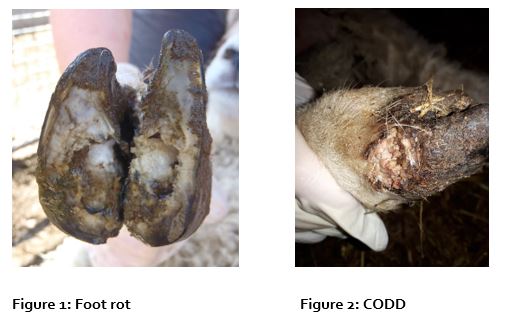- Home
- Lameness in sheep - treatment and diagnosis
Lameness in sheep - treatment and diagnosis
By Dr Jennifer Duncan, Department of Livestock and One Health & Dr Joseph W. Angell Wern Veterinary Surgeons, Department of Research and Innovation
“Summertime and the living is easy” - well I am not sure if that’s exactly the case for sheep farmers, as there is never a shortage of jobs to do, but it is worth reviewing at this time of year what’s happening with lameness in the flock. Summer is an ideal time to get on top of lameness to help prepare ewe flocks for a productive tupping period, ensuring lameness is not holding those lambs back from finishing and ensuring good animal welfare. Always talk to your vet right at the start of any review. They can make sure you have the right diagnosis for the conditions in the flock and will provide the most up to date advice on treatment and prevention.
Step 1: What’s the problem? Diagnosis
To start off you need to know what conditions you have and an idea of how much lameness you have in the flock.
There are multiple causes of lameness in sheep but the most important are the infectious foot diseases, footrot (Figure 1 - below) and contagious ovine digital dermatitis (CODD) (Figure 2 - below). Most flocks in the country will have some issues with footrot (this diagnosis also includes scald which often develops into footrot), and about half will have experienced CODD. Below is a pictorial guide, but the reality on farms is often not quite as clear cut and if in any doubt, contact your vet.

Step 2: How do we treat it? Treatment plans
There are quite a few different treatments and protocols for treating lame sheep. If you haven’t already, speak to your vet about creating an action plan to devise the most appropriate treatments tailored for your flock’s disease problems and circumstances. Each diseases will respond differently to different antibiotics, so there is no one-size-fits-all.
However, having said that the best advice is to treat individual sheep as soon as possible, usually with injectable long-acting antibiotic.
This works because:
- the earlier an infection is treated the more quickly and effectively it will clear
- it is vital for the sheep’s welfare
- it reduces disease spread
Fortunately, thanks to the work by the University of Warwick, one thing there is no longer any need to spend any time on is trimming sheep’s feet. In fact, trimming sheep’s feet is generally a bad idea under most circumstances as it can damage the hoof, delay healing and spread infection in the flock. So, put those clippers back in the shed unless you just need to trim a badly overgrown foot, and even then, don’t draw blood, don’t trim if any sign of infection and clean and disinfect hands/gloves between sheep.
Step 3: Where do we go from here? Controlling lameness
Again, there is no one-size-fits-all here, so you need to have a specific plan for your flock. However, there are some excellent general principles nicely summed up by the FAI Five Point Plan for controlling lameness in sheep flocks.
- Treat: prompt individual treatment of lame sheep
- Vaccinate: Footvax (MSD) programme is useful for footrot and CODD. You need to use it regularly (usually twice a year) and in the long term
- Hygiene: damp, wet muddy conditions underfoot are very important for encouraging disease spread. Keep field and housing as dry as possible, move field troughs to reduce muddy areas, fix water troughs, and clean and disinfect handling areas after use
- Biosecurity: don’t introduce new diseases. Check all feet on arrival, isolate for at least 3 weeks. If foot disease found, contact your vet for advice
- Cull chronic cases: these animals can harbour infection in your flock, and as footrot has a hereditary component you don’t want to be breeding from them
AHDB has funded much of the recent work on sheep lameness over the past few years. For more detailed advice see the AHDB Reducing Lameness manual
For more information on Contagious Ovine Digital Dermatitis (CODD) visit the Institute of Infection and Global Health website

